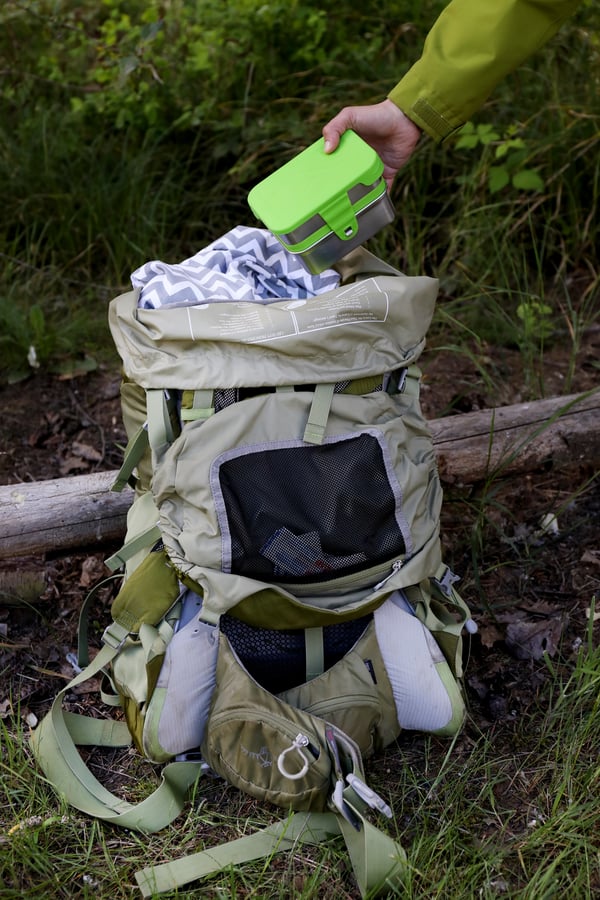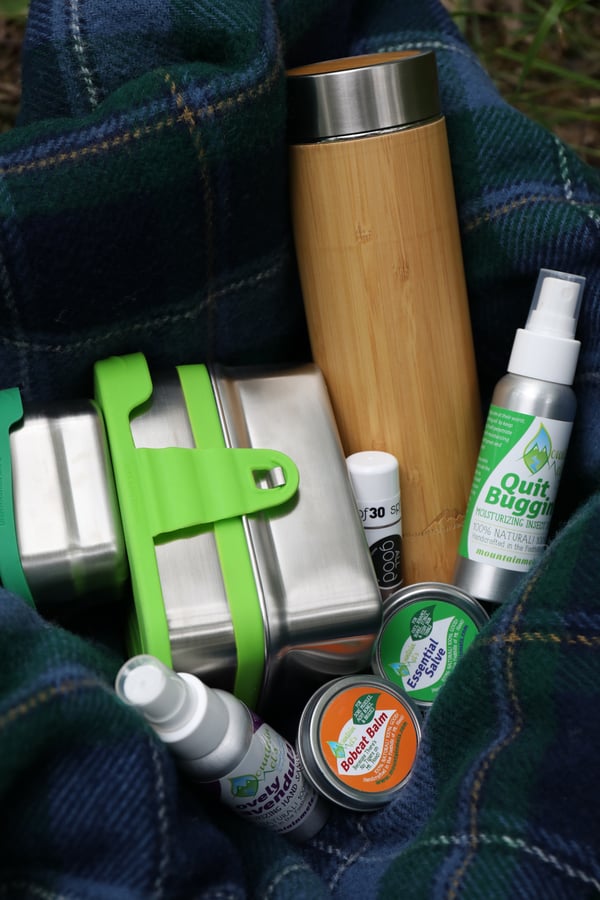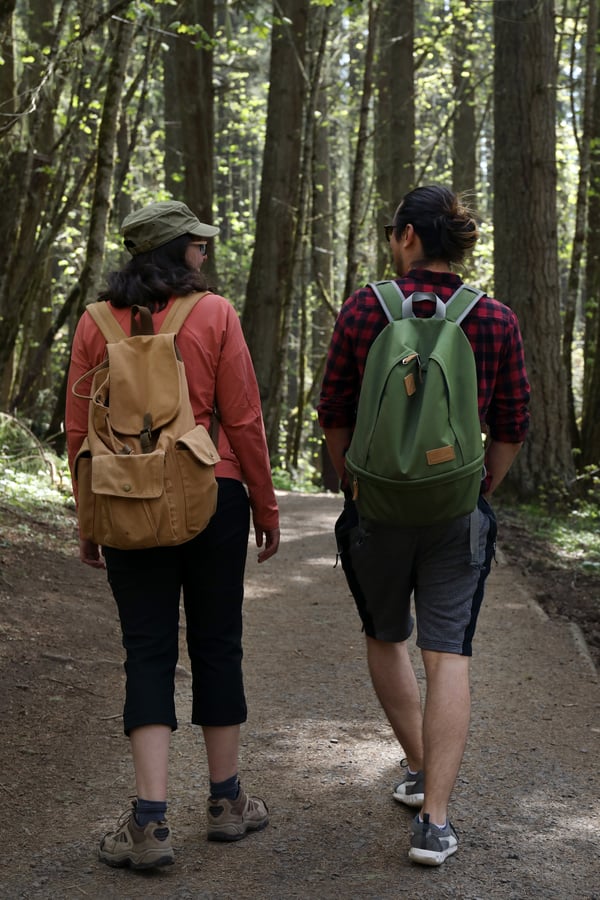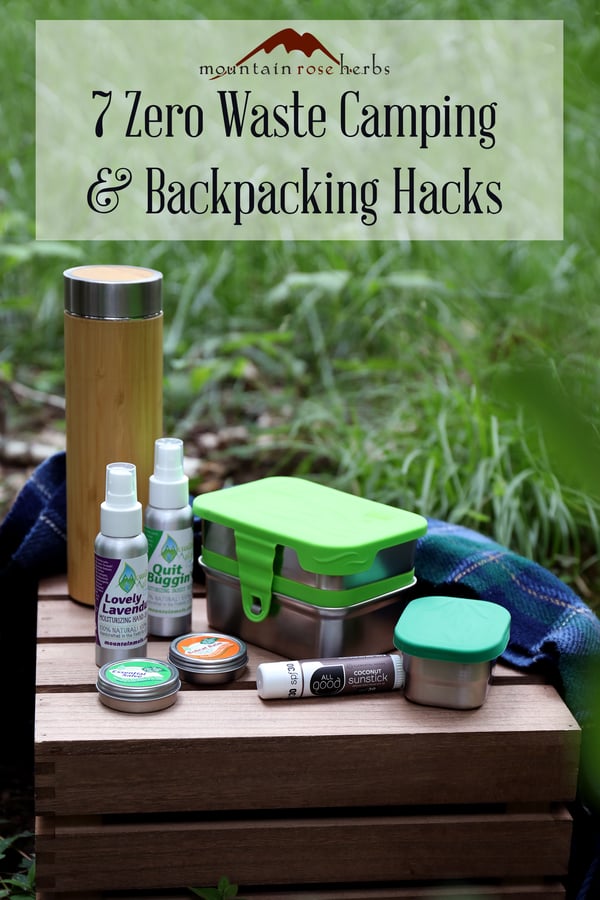Whether you’re hiking, camping, backpacking, or floating the river, you’ve got to fuel up while you play, but how can you do it in a sustainable way? While there are tons of dehydrated “backpacking food” options on the market today, their single-use packaging can add up to a pile of unrecyclable waste. Perhaps you never meant to leave a wrapper behind, but I can assure you, it’s bound to happen! That means your trash trail will either need to be packed out by someone else, or worse (and more likely), left to pose a choking hazard to wildlife. Luckily, there are many ways that you can immerse yourself in nature without waste—they just require a bit of planning!
Tips for Zero Waste Camping and Backpacking
- Preparation and Packaging: Bringing all of your unprepared grub in its original individual packages just creates more opportunities for waste and adds quite a bit of weight and/or bulk to your pack, which is never good. Hit up the bulk bins at your local store with a reusable cotton bag or two to stock up on low-mess, high-energy snacks like nuts, GORP, or dried fruits. Homemade energy bars or fruit leather make for a quick and convenient pick-me-up and can be stored in reusable food wraps or stainless-steel containers (see tips 2 and 3) for additional protection in your pack.
- Beeswax/Bee-Free Wraps: Reusable beeswax (and bee-free alternative) food wraps are the ultimate way to go in the backcountry. Backpackers will love that they pack down to a super tiny size and weigh next to nothing. They’re made of hemp or cotton cloth covered in a beeswax or plant wax-based coating, making them liquid-resistant, sturdy, and incredibly versatile. You can twist them, wrap them, or even roll them. They stick to themselves, so not only do they replace plastic, they may also sub in for aluminum foil for many common backcountry uses. You can use them to wrap a yummy sandwich, a burrito, veggies, or cheese, or turn them into a homemade granola holding pouch (you can even shape them into plates or bowls in a pinch!). The most cost-effective (not to mention fun and creative) way to add these food wraps to your gear collection is to make a batch yourself, but there are a number of solid ready-made options available as well. My favorite brand of beeswax wraps is Khala & Co. They’re an excellent family company, and (bonus!) they give to 1% For The Planet, so you can feel extra good about your new camping kitchen staples.
- Stainless-Steel Food Containers: It’s never a bad idea to invest in some high-quality stainless-steel food containers with secure lids. They’re nice and lightweight (unlike glass, which also has the potential to break), and they allow you to bring along delicate food stuffs like avocados without fear of smashing them (or getting them all over the rest of your gear). While they won’t pack down when you’re finished with the goodness you packed inside, they will hold your dirty socks, treasures, used beeswax cloths, or whatever you need to pack out. Check out the offerings at your local outdoor or kitchen store, which often include Eco Lunchboxes, one of my favorite options for travel and for toting my work day lunches.
- Stainless-Steel Water, Tea, or Wine Bottles: If you haven’t invested in some good stainless and portable drinkware yet, you most certainly should. You can throw them around, drop them off a cliffside (not recommended!), or let them trail you down the rapids, and never worry about broken glass or single-use plastic being left behind. Mountain Rose Herbs offers an awesome bamboo and stainless-steel to-go tumbler with infuser for easy prep of loose leaf (or wildcrafted!) tea along the trail.
- For a basic bottle, I personally love Klean Kanteen because it’s another fantastic company that gives back through 1% for The Planet, and their products are awesome! These rugged jugs stand up to use, won’t leak, and can be deep cleaned between uses, making them ideal for toting your water or more “adult” beverages. Another great use for these bottles during winter camping is sleeping with a hottie (yep, you read correctly!). Steamy as it may sound, this simply means that you heat boiling water at night before bed, pour it into your water bottle, secure the lid, and then wrap your water bottle in a thick sock or shirt. Bam!—you’ve got an amazing heater to warm up your sleeping bag.
- Wet Bags for Trash (and More!): There are countless times when you need to keep wet and dry items (or clean and dirty ones) separated during your adventures, and that’s where sealable and flexible water-tight bags can save the day! When I hit the trail for an extended trip, I pack it all out with Planet Wise. I was first introduced to this company when we were cloth diapering our daughter (yes, we went backpacking with cloth diapers and a 4 month old—it’s possible, I promise!). When you’re toting food alongside its byproduct, you REALLY need to be able to trust your bag, and these excellently made pouches never let us down. If an infant isn’t on your packing list, these sacks have tons of uses beyond containing dirty diapers. I mean, who doesn’t need a plastic-free reusable trash bag with a cute and stylish fabric? They come in a variety of sizes, allowing you to use them for granola or other tiny snacks, for coffee grounds, loose tea, compost, or what little waste you have left to pack out. You could even use them to pack out your toilet paper (more on that in a bit).
- Portable Utensils: Pack your reusable spork, fork, knife, spoon, chopsticks, or whatever your favorite utensil/s may be. Often, you can find multitool-style combos for camping that provide a whole place setting in one handy package, but you can also just bring along an old set of lightweight stainless steel or wooden utensils snagged from a thrift store or yard sale. If you do opt for a nice all-in-one version, I highly recommend securely tethering it to your pack or food bowl if at all possible to reduce the risk of leaving it for the birds (trust me, they don’t want it!).
- Tools to Deal with “Personal” Waste: Since we’re talking about waste in the backcountry, let's take a moment to discuss our own human waste, because this seems to be more and more of an issue every year. Nobody, I mean NOBODY likes to arrive at a beautiful spot after a long trek, only to look behind a tree and see a bunch of wadded up toilet paper and human feces, and it makes me weep to think of how many times that happens. So, what should you do when you’ve got to poo?
Bring a trowel, dig a hole at least six inches deep, and keep your dug up dirt in a nice pile next to the hole. Drop your drawers and take care of business as you aim for the hole. Honestly, the air is refreshing! Set your used toilet paper aside. When finished, remember to leave your used area looking like it did before. Cover it with leaves, sticks, and other natural debris nearby. If you’re camping with others, leave a stick sticking out of it, so others don’t try to dig where you just pooped. Retrieve your toilet paper. Here’s where one of your (specially designated) wet bags can be really awesome. You can pack out your own toilet paper or carry it to the campfire to burn it away (just try to avoid the smoke while it’s burning). When packing out the toilet paper with your bag, you can just empty it when you get home before tossing the bag straight into the washer, super simple. This trick also works for feminine hygiene products, if you haven’t adopted a menstrual cup into your routine. For a post-session cleanse, wash with a small piece of natural soap and water, or give yourself a pump of natural moisturizing hand sanitizer when a full washup isn’t an option.
A note on TP use. While many advocate using leaves for cleaning up after “number two,” appropriate options aren’t always easily available, can be stiff and not of ideal texture for effective wiping, and may cause some serious problems if you happen to choose the wrong type—identifying poison oak is easy enough, but a bathroom break is NOT the time to discover your own personal allergy to some other generally innocuous plant. For these reasons, you may reasonably opt to bring toilet paper along for your hike, but it’s important to remember that it is NOT part of nature and requires proper disposal. And ladies, you don’t need to wipe with toilet paper every time you pee behind a tree, I promise! You can do the drip and shake dance, or bring along a designated bandana or other soft cloth in a resealable bag for a quick pat dry (you can rinse it with a bit of soap and water and hang it from your pack to dry between uses).
Hopefully you’re now ready to jump into summer fun and truly leave no trace! While you’re getting ready, please remember that the products you put on your body not only affect your own health but also the health of our planet, so please choose sustainable, environmentally friendly body care products when you’re out there. And planning is always better in groups, so make sure to share these pro tips with your outdoorsy companions so they can reduce their bootprints as well!
Want a Quick and Natural Way to Freshen Up in the Woods?
Bring Along Some DIY Dry Shampoo!
You might also enjoy:















